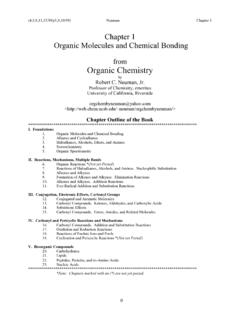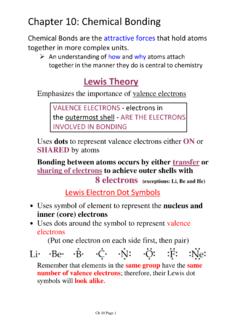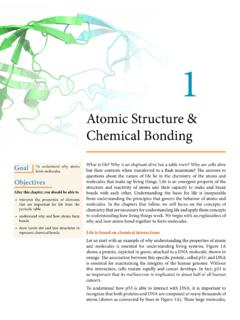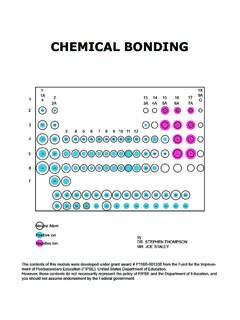Search results with tag "Chemical bonds"
from Organic Chemistry
chemistry.ucr.eduBesides their chemical bonds (bonding electron pairs), we show that N, O, and F have unshared electron pairs that are not in chemical bonds. The combined total of number of bonds and number of unshared electron pairs that we show equals 4 for C, N, O, or F. Since each chemical bond contains 2 electrons, our drawings of these molecules show 8 ...
Chapter 10: Chemical Bonding
webs.anokaramsey.eduMain Classes of Chemical Bonds Ch 10 Page 13 . Can show the direction of bond polarity with δδδδ+ and δδδδ-and/or a special arrow: Show the direction of bond polarity for the bond in HCl. AND It must have polar bonds It must have an unsymmetrical shape
Atomic Structure & Chemical Bonding - Harvard University
projects.iq.harvard.edurepresent chemical bonds. After this chapter, you should be able to To understand why atoms form molecules. Objectives Goal. Chapter 1 Atomic Structure & Chemical Bonding 2 or macromolecules, interact with one another because particular atoms in one molecule are attracted to particular atoms in the other molecule.
ANDHRA PRADESH PUBLIC SERVICE …
psc.ap.gov.inOrbitals, shapes of s, p and d orbitals - Electronic configurations of elements Chemical Bonding: Introduction – types of chemical bonds – Ionic and covalent bond with examples–Properties of Ionic and Covalent compounds- structures of ionic crystals (NaCl and CsCl). 2. Solutions
Student Exploration: Covalent Bonds
hannahsonnentag.weebly.comtends to form a certain number of chemical bonds. This valueis the valence of the element. For each element in the table below, use the Gizmo to find the number of valence electrons and the list the valence based on the Lewis diagram. Then find the sum of these numbers. Element
Basic Concepts of Chemical Bonding
www.lamar.eduCHEMICAL BONDS attractive force holding atoms together Single Bond: involves an electron pair e.g. H 2 Double Bond: involves two electron pairs e.g. O 2 Triple Bond: involves three electron pairs e.g. N 2
Chapter 1 Structure and Bonding - Michigan State University
www2.chemistry.msu.eduA molecular orbital (MO): where electrons are most likely to be found (specific energy and general shape) in a molecule Additive combination (bonding) MO is lower in energy Subtractive combination (antibonding) MO is higher energy 1.11 Describing Chemical Bonds: …
chemical bond bonds - scienceattech.com
scienceattech.comCHM 110 - The Basics of Bonding (r14) - ©2014 Charles Taylor 1/7 Introduction The concept at the heart of chemistry is that of the chemical bond. The chemical ... We can represent both ionic and covalent bonds with a graphical notation known as the Lewis dot structure.
CHEMICAL BONDING AND MOLECULAR STRUCTURE
ncert.nic.inchemical bonds. In the case of sodium and chlorine, this can happen by the transfer of an electron from sodium to chlorine thereby giving the Na+ and Cl– ions. In the case of other molecules like Cl 2, H2, F2, etc., the bond is for med by the sharing of a pair of electr ons between the at oms. In the pr ocess each atom
Chemical Bonding - Colorado State University
www.smallscalechemistry.colostate.eduChemical bonding determines the physical properties of substances. These properties are listed below for covalent, ionic and metallic bonding. List and describe some substances which do not seem to fi t into any of the three types of bonding. PROPERTIES CONTROLLED BY CHEMICAL BOND 5









